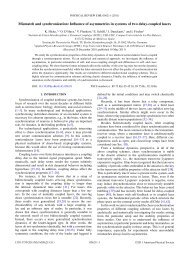DBI Analysis of Open String Bound States on Non-compact D-branes
DBI Analysis of Open String Bound States on Non-compact D-branes
DBI Analysis of Open String Bound States on Non-compact D-branes
You also want an ePaper? Increase the reach of your titles
YUMPU automatically turns print PDFs into web optimized ePapers that Google loves.
CHAPTER 1. INTRODUCTION 6sight seems like six too many, which brings al<strong>on</strong>g the challenge <str<strong>on</strong>g>of</str<strong>on</strong>g> making those extradimensi<strong>on</strong>s “invisible.”Another compelling feature is that string theory requires supersymmetry. Also, yousimply can not ignore gravity; it is embedded in it from the very <str<strong>on</strong>g>of</str<strong>on</strong>g>fset.At <strong>on</strong>e point, string theory appeared to be “diversified,” and loose its uniqueness.Several “flavours” <str<strong>on</strong>g>of</str<strong>on</strong>g> c<strong>on</strong>sistent superstring theories were known, and at first sight, theywere not related. However, it was found out afterwards that in fact all <str<strong>on</strong>g>of</str<strong>on</strong>g> these theorieswere related by an intricate play <str<strong>on</strong>g>of</str<strong>on</strong>g> dualities. As a c<strong>on</strong>sequence, string theory regainedits uniqueness.Of course, all is not peace and love in string land. The theory has its flaws. For<strong>on</strong>e, the exact descripti<strong>on</strong> that gives rise to the physics as they are described by theStandard Model is as <str<strong>on</strong>g>of</str<strong>on</strong>g> yet still unknown. Also, giving the right mass to particlesis still a challenge. But most <str<strong>on</strong>g>of</str<strong>on</strong>g> all, string theory has failed so far to make even <strong>on</strong>esingle experimentally verifiable prediciti<strong>on</strong>. It has already made many predicti<strong>on</strong>s, butthey are simply vastly out <str<strong>on</strong>g>of</str<strong>on</strong>g> reach <str<strong>on</strong>g>of</str<strong>on</strong>g> modern day experiments. On the other handhowever, the development <str<strong>on</strong>g>of</str<strong>on</strong>g> string theory has given rise to many new insights into newmathematics and old physics alike. Moreover, the elegance and c<strong>on</strong>strictiveness <str<strong>on</strong>g>of</str<strong>on</strong>g> itsformulati<strong>on</strong>, as well as the many fundamental answers that seem to be lurking behindthe corner, easily justify its place at the top <str<strong>on</strong>g>of</str<strong>on</strong>g> modern theoretical physics.1.2 A brief history <str<strong>on</strong>g>of</str<strong>on</strong>g> string theoryThis secti<strong>on</strong> will summarily walk through some <str<strong>on</strong>g>of</str<strong>on</strong>g> the major steps in the history <str<strong>on</strong>g>of</str<strong>on</strong>g> stringtheory so far.1968: the seed from which string theory would eventually grow was sown in this year,during a time in which much study was devoted to the understanding <str<strong>on</strong>g>of</str<strong>on</strong>g> the str<strong>on</strong>ginteracti<strong>on</strong>s, and understanding the hadr<strong>on</strong>ic spectrum and the many res<strong>on</strong>ances fromstates with ever increasing spin that kept being discovered. Phenomenology showed thatmany <str<strong>on</strong>g>of</str<strong>on</strong>g> these res<strong>on</strong>ances appeared to respect a linear behaviour between their mass andtheir spin,m 2 = J α ′ + α 0, (1.1)with m the mass, J the spin, α ′ the Regge-slope and α 0 the intercept. On the other hand,when c<strong>on</strong>sidering four-particle scattering amplitudes (see Fig. 1.2) a duality betweenthe s- and t-channels appeared to exist, in that it could be shown (with the help <str<strong>on</strong>g>of</str<strong>on</strong>g>experimental data) that the amplitude for the s-channel and t-channel corresp<strong>on</strong>dedfor small enough values <str<strong>on</strong>g>of</str<strong>on</strong>g> s and t. This was called the “duality hypothesis,” and thissuggested that it should be possible to write down an amplitude A(s, t) that was invariantunder the exchange s ←→ t. Veneziano managed to write down such an amplitude bymaking use <str<strong>on</strong>g>of</str<strong>on</strong>g> Euler’s β-functi<strong>on</strong>,A(s, t) =Γ (−α(s)) Γ (−α(t)), (1.2)Γ(−α(s) − α(t))
















